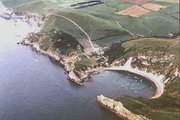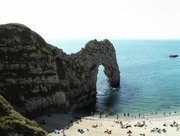Jurassic Coast
|
|
The Jurassic Coast is a World Heritage Site in south England. The 95 mile (155km) long site starts at Orcombe Point near Exmouth in East Devon and ends at Old Harry Rocks near Swanage in East Dorset. The site consists of Triassic, Jurassic and Cretaceous cliffs spanning the Mesozoic Era, documenting 180 million years of geological history.
The site contains a number of unique geological features and landforms, and shows excellent examples of different landforms, including the natural arch at Durdle Door, as well as the cove and limestone folding at Lulworth. Chesil Beach has fine examples of both tombolos and storm beaches. The site has stretches of both concordant and discordant coastlines. The site is the subject of international field studies because of the quality of the geology and the example of management.
It was featured on the TV programme Seven Natural Wonders as one of the wonders of the South West.
| Contents |
Formation
West_Bay,_Dorset.jpg
At the start of the Jurassic period a sea level rose flooding the Triassic landscape. For most of the Jurassic period Dorset was under a tropical sea, and marine life flourished. Sediments accumulated over time, mud in deep parts, sand in shallow parts, forming shale (Kimmeridge), limestone (Lulworth to Portland) and sandstone (Studland). The bodies of dead marine animals, including dinosaurs were preserved in these sediments. A large number of particularly high quality finds were uncovered at Kimmeridge and Lyme Regis. The waters slowly fell and dinosaur footprints have been found embedded in the rocks.
In the cretaceous period the sea level rose again, this laid down more sediments which made the chalk (Old Harry Rocks, White Nothe, behind Lulworth Cove) and clays (between the Limestone and Chalk at Lulworth).
In places the earth's movement buckled the rock, forming features like the Lulworth Crumple formation. The layout of the rock, and shape of the coast making the concordant and discordant coastlines of the purbecks have led to the formation of features such as Lulworth Cove. Here the limestone has been breached and the soft clays eroded, pockets have formed under the clays where oil has accumulated as the largest onshore oil field in Britain.
Features of interest
- Chesil Beach (tombolo, storm beach)
- Chit Rocks (Stacks, stumps)
- Durdle Door (Natural arch, caves)
- Durlston Country Park
- Isle of Portland
- Kimmeridge (Rocky shore, wave cut platform, fossils)
- Lulworth Cove (Cove, Lulworth crumple)
- Studland Bay (Beach, psammosere)
- The Fleet (saline lagoon behind Chesil Beach)
Gateway towns
See also

- Mary Anning - Local Paleontologist, who studied the fossils at Lyme Regis and discovered the first complete Ichthyosaur fossil near Lyme.
- Geology of the United Kingdom
External links
- UNESCO's page on the Jurassic Coast (http://whc.unesco.org/sites/1029.htm)
- UNEP's page on the Jurassic Coast (http://www.unep-wcmc.org/sites/wh/dorset.html)
- The Dorset Coast Forum (http://www.dorsetcoast.com/)
- South West Grid for Learning, Dorset Coast Forum, Countryside Agency and Dorset & Devon County Council joint Jurassic Coast site (http://www.swgfl.org.uk/jurassic/)
- National Geographic article on the Jurassic Coast (http://news.nationalgeographic.com/news/2001/12/1214_wirejurassicuk.html)
- BBC News Article on the Jurassic Coast (http://news.bbc.co.uk/1/hi/england/1708397.stm)
- Dorset and Devon county councils Jurassic Coast site (http://www.jurassiccoast.com)
- Information, History, Photos etc (http://www.theheritagecoast.co.uk)
- Dr Ian West's page including a lot of information on the Geology of the coast (http://www.soton.ac.uk/~imw/)
- Photographs (http://www.steinsky.me.uk/Jurassic_Coast)



